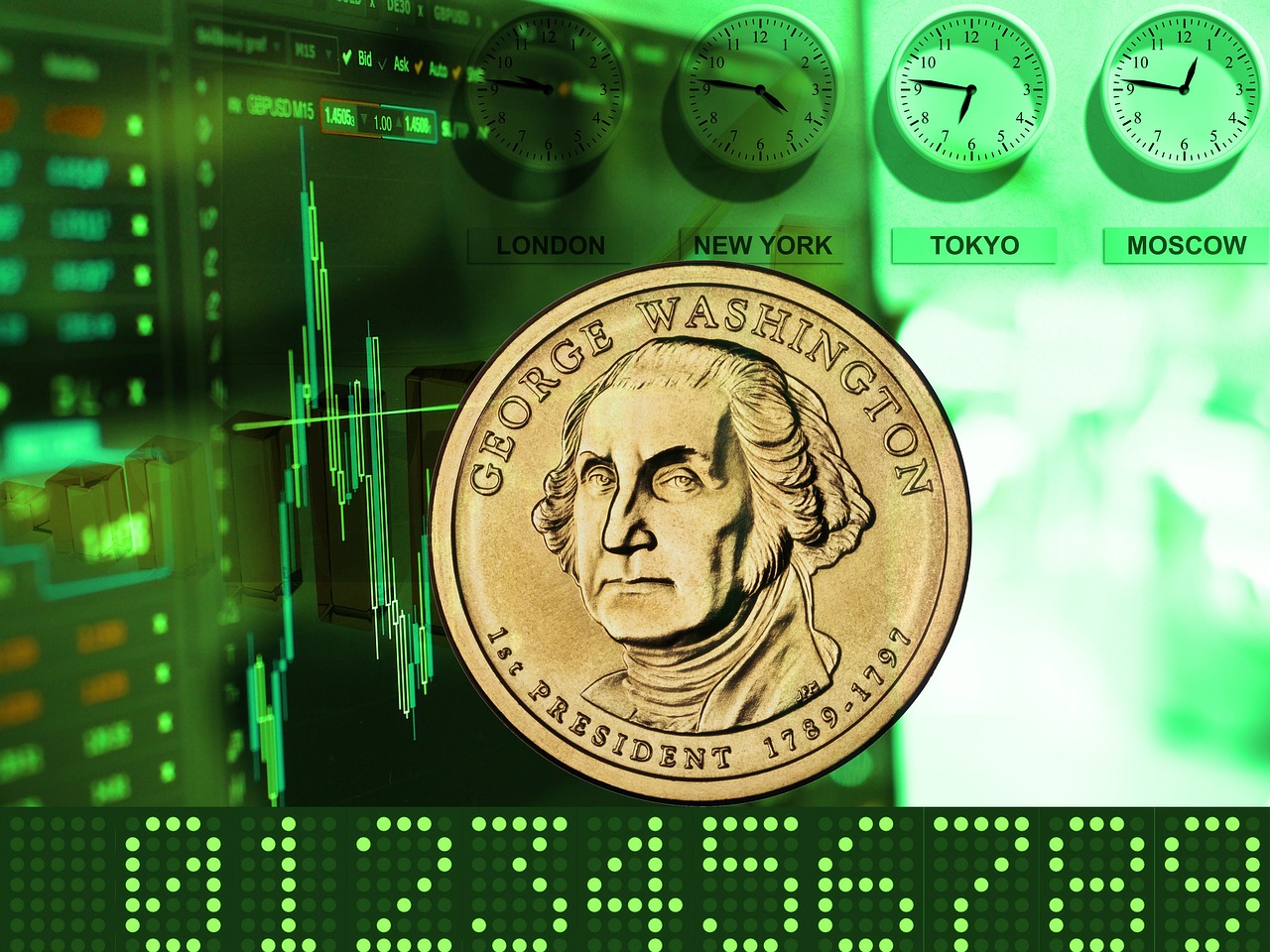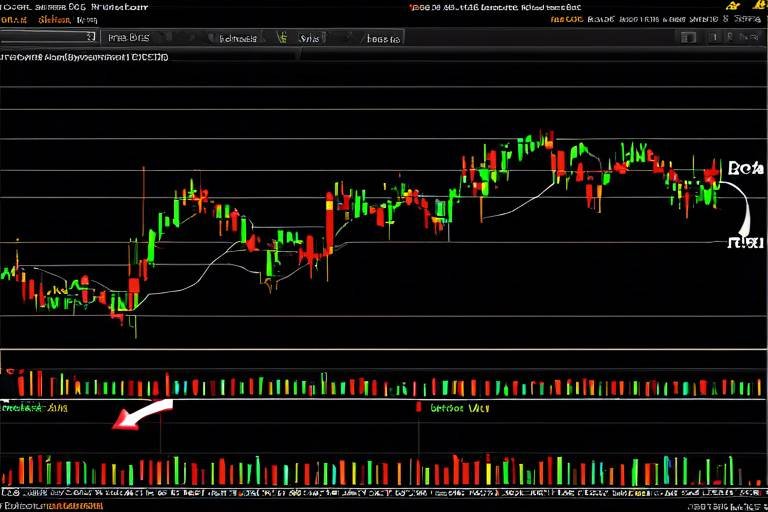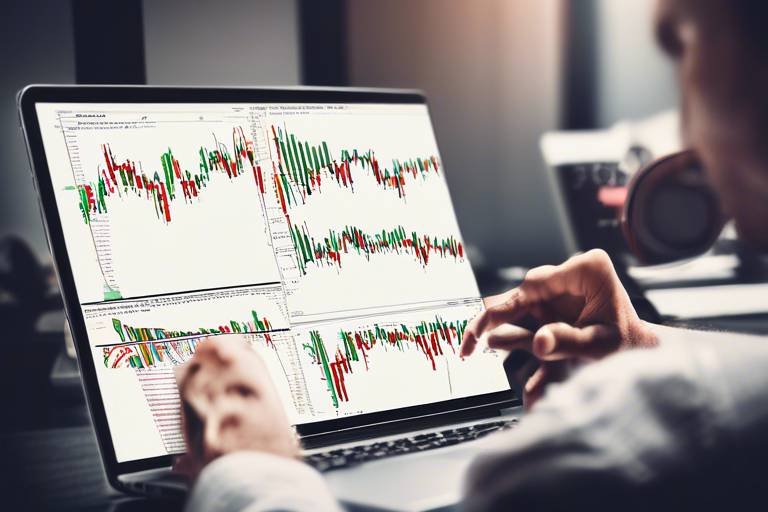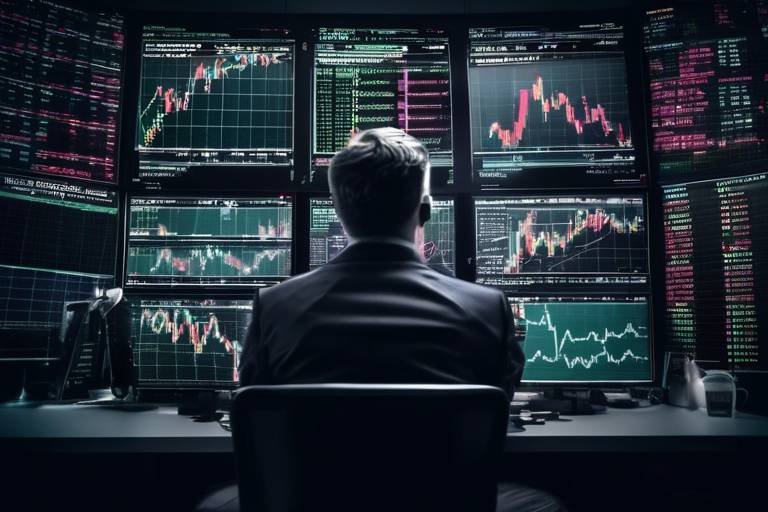5 Proven Strategies for Successful Day Trading in Crypto
Day trading in the cryptocurrency market can be an exhilarating yet daunting experience. As a trader, you are not just buying and selling; you are navigating a volatile landscape that can change in the blink of an eye. With the right strategies, however, you can enhance your trading experience and potentially increase your profits. In this article, we will explore five proven strategies that can help you thrive in the fast-paced world of crypto day trading. From understanding market trends to mastering technical analysis, we will cover it all. So, buckle up and get ready to dive into the thrilling universe of day trading!
Recognizing market trends is crucial for day traders. Imagine standing on the shore, watching the waves roll in and out; you need to understand which way the tide is going. In the world of crypto, this means identifying bullish and bearish trends. A bullish trend indicates rising prices, while a bearish trend signifies falling prices. By analyzing these trends, you can make informed trading decisions that align with the market's direction. To effectively identify these trends, traders often use various indicators, such as moving averages and trend lines, which serve as a compass in the unpredictable waters of cryptocurrency.
Technical analysis tools play a vital role in day trading. They are like the instruments in a pilot's cockpit, helping you navigate through turbulence. By utilizing various indicators and charting techniques, traders can predict price movements and optimize their strategies. Some of the most commonly used tools include moving averages, Bollinger Bands, and Relative Strength Index (RSI). Each of these tools offers unique insights into market behavior, allowing traders to make educated decisions based on historical price patterns.
Moving averages are essential for smoothing price data and identifying trends. Think of them as a safety net that helps you catch the overall direction of the market. There are two primary types of moving averages that traders often use: the Simple Moving Average (SMA) and the Exponential Moving Average (EMA). Each has its unique applications, and understanding their differences can significantly enhance your trading strategy.
The Simple Moving Average (SMA) is one of the most basic indicators in a trader's toolkit. It calculates the average price of a cryptocurrency over a specific time period, providing a clear view of the price trend. To calculate the SMA, simply add the closing prices of the asset over a defined number of periods and divide by that number. For example, a 10-day SMA would take the average of the last 10 days' closing prices. Traders often use the SMA to identify support and resistance levels, making it a fundamental tool for effective trading decisions.
The Exponential Moving Average (EMA) gives more weight to recent prices, making it more responsive to new information. This means that the EMA can help traders spot trends earlier than the SMA. In practice, traders often use the EMA for determining entry and exit points, as it helps in identifying potential reversals and continuations in price action. By incorporating both the SMA and EMA into your trading strategy, you can create a more robust framework for decision-making.
Chart patterns provide visual cues for potential price movements, acting like a roadmap for traders. Just as a skilled detective reads clues to solve a mystery, traders analyze these patterns to predict future price actions. Common patterns include head and shoulders, flags, and triangles. Each pattern carries its significance; for instance, a head and shoulders pattern often indicates a reversal, while flags signify a continuation of the trend. By recognizing these patterns, traders can position themselves advantageously in the market.
Effective risk management is essential for long-term success in day trading. It's akin to wearing a seatbelt while driving; it protects you from potential dangers. This section outlines various techniques to safeguard your capital and minimize losses. One of the most critical aspects of risk management is setting stop-loss orders. These orders automatically close your position when the price reaches a predetermined level, helping to limit your losses in volatile markets.
Stop-loss orders are crucial for limiting potential losses. To set effective stop-loss levels, consider market conditions and your personal risk tolerance. For example, if you’re trading a highly volatile cryptocurrency, you might want to set a wider stop-loss to avoid being stopped out prematurely. Conversely, for more stable assets, tighter stop-loss levels may be more appropriate. By strategically placing your stop-loss orders, you can protect your trading capital and maintain your psychological well-being.
Position sizing determines how much capital to allocate to each trade. This is critical for managing risk effectively. A common approach is to risk only a small percentage of your trading capital on any single trade—typically between 1% to 3%. By calculating optimal position sizes based on your total capital and risk tolerance, you can ensure that no single trade can significantly impact your overall portfolio.
Day trading requires mental fortitude and discipline. It’s not just about numbers; it’s about mastering your mind. Psychological preparedness is vital for successful trading, as it involves managing emotions and maintaining a trading journal for self-reflection. By recognizing your emotional triggers, you can develop strategies to stay calm under pressure and make rational decisions.
Maintaining emotional control is vital for traders. Common psychological pitfalls include fear and greed, which can cloud judgment and lead to poor decisions. Developing techniques to manage these emotions, such as mindfulness and visualization, can significantly enhance your trading performance. Remember, trading is a marathon, not a sprint; maintaining a level head can help you navigate the ups and downs of the market.
A well-defined trading plan is essential for success. Think of it as your trading blueprint. An effective trading plan should include your goals, strategies, and performance evaluation methods. By having a clear plan in place, you can stay focused and disciplined, making it easier to stick to your trading strategy even in the face of market volatility.
The cryptocurrency market is constantly evolving. To stay relevant and successful in day trading, it's crucial to embrace continuous learning and adapt your strategies. This means keeping an eye on emerging trends, new technologies, and changes in market sentiment. Regularly reviewing and adjusting your trading strategies will enable you to refine your approach and improve your performance over time.
Staying informed about market news and events is crucial for traders. Resources such as news websites, social media platforms, and cryptocurrency forums can provide valuable insights into market movements. By keeping up with the rapidly changing crypto landscape, you can make more informed trading decisions and capitalize on new opportunities.
Regularly reviewing and adjusting trading strategies is essential for improvement. Take the time to evaluate past trades, analyze what worked and what didn’t, and refine your approaches for future success. This ongoing process of self-assessment will not only enhance your trading skills but also boost your confidence as a trader.
- What is day trading in cryptocurrency? Day trading involves buying and selling cryptocurrencies within the same day to capitalize on short-term price movements.
- How much money do I need to start day trading? While there is no set amount, starting with a few hundred to a few thousand dollars is common, depending on your risk tolerance and trading strategy.
- What are the risks of day trading? Day trading carries risks such as high volatility, emotional stress, and the potential for significant financial loss.
- Can I day trade crypto without experience? While it’s possible, gaining knowledge about trading strategies, market trends, and risk management is highly recommended for success.

Understanding Market Trends
Recognizing market trends is crucial for day traders, and it can feel like trying to navigate a maze without a map. Just like a sailor uses the stars to find their way, traders rely on trends to steer their decisions. A bullish trend indicates that prices are generally rising, while a bearish trend suggests that prices are falling. Understanding these trends can provide traders with a significant advantage in the fast-paced world of cryptocurrency.
But how do you identify these trends? It all starts with observing price movements over time. Traders typically analyze price charts to spot patterns that indicate whether the market is heading up or down. The importance of trend analysis cannot be overstated; it helps traders make informed decisions about when to enter or exit a trade. For instance, entering a trade during a bullish trend can increase the likelihood of profiting, while entering during a bearish trend may lead to losses.
To better grasp market trends, consider these key components:
- Timeframes: Trends can be identified on various timeframes, from minutes to hours, days, or even weeks. Understanding the timeframe that suits your trading style is essential.
- Volume: Analyzing trading volume can provide insight into the strength of a trend. Higher volumes often confirm a trend's direction.
- Market Sentiment: The overall mood of the market can influence trends. Are traders feeling optimistic or pessimistic? Sentiment analysis can help gauge this.
Another effective method for identifying trends is using technical indicators. These tools can help traders visualize trends and make data-driven decisions. For example, the Moving Average is a popular indicator that smooths out price data to identify the direction of the trend. By using a combination of these tools and techniques, traders can enhance their ability to spot trends and capitalize on them.
In summary, understanding market trends is like having a compass in the chaotic world of cryptocurrency trading. By recognizing bullish and bearish trends, leveraging technical indicators, and considering market sentiment, you can navigate your trades with confidence. Remember, the key to successful day trading lies not just in recognizing these trends but also in adapting your strategies to align with them.

Technical Analysis Tools
When it comes to day trading in the cryptocurrency market, understanding is not just beneficial; it’s essential. These tools help traders make informed decisions based on price movements and market trends. By analyzing historical price data and trading volumes, you can predict future movements and optimize your trading strategies. The beauty of technical analysis lies in its ability to provide a structured approach to trading, turning what could be a chaotic experience into a more manageable and calculated endeavor.
One of the most fundamental aspects of technical analysis is the use of indicators. These indicators can range from simple calculations to complex algorithms and are designed to help traders identify potential entry and exit points. Some of the most popular indicators include moving averages, Relative Strength Index (RSI), and Bollinger Bands. Each of these tools serves a unique purpose and can be used in conjunction with one another to enhance your trading strategy.
For instance, moving averages smooth out price data to help identify trends over a specific period. They can be particularly useful in spotting bullish or bearish trends. Meanwhile, the RSI helps traders determine whether a cryptocurrency is overbought or oversold, providing additional context for making trading decisions. By combining these tools, traders can gain a more comprehensive view of the market, leading to better-informed decisions.
Moving averages are essential for smoothing price data and identifying trends. They come in various forms, primarily the Simple Moving Average (SMA) and the Exponential Moving Average (EMA). The SMA calculates the average price over a specific number of periods, while the EMA gives more weight to recent prices, making it more responsive to new information. Understanding the differences between these two types can significantly impact your trading strategy.
The Simple Moving Average (SMA) is one of the most basic indicators in technical analysis. To calculate the SMA, you simply add the closing prices of a cryptocurrency over a certain period and then divide that sum by the number of periods. For example, a 10-day SMA would take the closing prices from the last ten days. This indicator helps traders identify the overall direction of the market. If the current price is above the SMA, it may indicate a bullish trend, while prices below the SMA could suggest a bearish trend.
The Exponential Moving Average (EMA), on the other hand, provides a more nuanced approach by giving more weight to recent price movements. This makes the EMA a more sensitive indicator, which can be particularly helpful for day traders looking for quick entry and exit points. Traders often use the EMA in conjunction with the SMA to confirm trends and potential reversals. For example, a common strategy is to look for crossovers between the short-term EMA and the long-term SMA as signals for buying or selling.
Chart patterns are another vital component of technical analysis. These patterns provide visual cues that can indicate potential price movements. For example, formations like head and shoulders, flags, and triangles can suggest whether a price movement is likely to continue or reverse. Recognizing these patterns can give traders an edge in predicting future price action. Understanding the psychology behind these patterns is equally important, as they often reflect collective market sentiment.
In conclusion, leveraging technical analysis tools can significantly enhance your day trading experience. By mastering indicators like moving averages and recognizing chart patterns, you’ll be better equipped to navigate the volatile cryptocurrency market. Remember, the key to successful trading is not just in knowing these tools but in knowing how to apply them effectively.
Q: What is technical analysis in cryptocurrency trading?
A: Technical analysis involves evaluating historical price data and trading volumes to predict future price movements and make informed trading decisions.
Q: Why are moving averages important?
A: Moving averages help smooth out price data and identify trends, making them essential for spotting potential entry and exit points in trading.
Q: How do I choose the right indicators?
A: The choice of indicators depends on your trading strategy. It's often beneficial to combine multiple indicators to get a more comprehensive view of the market.
Q: Can I rely solely on technical analysis?
A: While technical analysis is a powerful tool, it's best used in conjunction with other forms of analysis, such as fundamental analysis and market sentiment.

Moving Averages
When it comes to day trading in the cryptocurrency market, are your best friends. They act like a compass, guiding you through the turbulent waters of price fluctuations. By smoothing out price data over a specific period, moving averages help traders identify the direction of the trend, making it easier to make informed decisions. But how do you actually use them? Let’s break it down.
There are two primary types of moving averages that every trader should be familiar with: the Simple Moving Average (SMA) and the Exponential Moving Average (EMA). Both serve the same purpose of trend identification, but they do it in slightly different ways. The SMA calculates the average price over a set number of periods, while the EMA gives more weight to the most recent prices, making it more responsive to new information. This difference can significantly affect your trading strategy.
To illustrate how these moving averages work in real-time, let’s consider a simple example. Imagine you’re analyzing the price of Bitcoin over the last ten days. The SMA would take the closing prices of Bitcoin for those ten days, add them up, and divide by ten to give you the average price. On the other hand, the EMA would apply a formula that gives more importance to today’s price, allowing it to react faster to price changes. This responsiveness can be crucial for day traders looking to capitalize on short-term price movements.
| Type of Moving Average | Calculation Method | Best Used For |
|---|---|---|
| Simple Moving Average (SMA) | Average of closing prices over a specified number of periods | Identifying long-term trends |
| Exponential Moving Average (EMA) | Weighted average that gives more importance to recent prices | Capturing short-term trends |
Now that you understand the basics, let’s talk about how to apply them in your trading strategy. A common approach is to use a combination of both SMA and EMA. For instance, you might set up a strategy where you buy when the EMA crosses above the SMA, indicating a potential upward trend. Conversely, you might sell when the EMA crosses below the SMA, signaling a downward trend. This crossover strategy can be a powerful tool in your trading arsenal.
However, it’s important to remember that moving averages are lagging indicators. They reflect past price movements rather than predict future ones. This means they should be used in conjunction with other technical analysis tools and indicators to confirm signals. Think of moving averages as part of a larger puzzle; they provide valuable insights, but they aren’t the whole picture.
In summary, moving averages are an essential component of day trading in crypto. They help you identify trends, determine entry and exit points, and refine your trading strategy. Whether you prefer the simplicity of the SMA or the responsiveness of the EMA, incorporating these tools into your trading routine can enhance your chances of success. So, why not give them a try? You might just find that they become your new best friends in the world of cryptocurrency trading!
- What is the difference between SMA and EMA? The SMA calculates the average of past prices equally, while the EMA gives more weight to recent prices, making it more responsive to price changes.
- How can I use moving averages in my trading strategy? You can use moving averages to identify trends and set up crossover strategies, where you buy or sell based on the relationship between the SMA and EMA.
- Are moving averages effective for all cryptocurrencies? While moving averages can be useful for many cryptocurrencies, their effectiveness can vary based on market conditions and volatility.

Simple Moving Average (SMA)
The is one of the most fundamental tools in the arsenal of a day trader. Essentially, it's a way to smooth out price data over a specific time period, which helps to identify the general direction of the market. Imagine trying to spot a trend while riding a roller coaster; the SMA acts like a steadying hand, giving you a clearer view of where the market is heading without the dizzying ups and downs. By calculating the average price over a set number of days, traders can eliminate some of the noise and focus on the underlying trend.
To calculate the SMA, you simply add up the closing prices for a set number of periods and then divide by that number. For instance, if you want to calculate the 10-day SMA, you would add the closing prices of the last 10 days and divide by 10. This straightforward approach makes it accessible for both novice and seasoned traders alike. Here's a quick formula:
SMA (P1 + P2 + P3 + ... + Pn) / n
Where P represents the closing prices and n is the number of periods. The beauty of the SMA lies in its simplicity. However, it's essential to understand that while the SMA can provide valuable insights, it also comes with limitations. For instance, because it gives equal weight to all prices in the calculation, it can lag behind current price movements, which might lead to missed opportunities.
Traders often use the SMA in conjunction with other indicators to enhance their decision-making process. For example, combining the SMA with other moving averages, like the Exponential Moving Average (EMA), can help traders spot potential buy or sell signals. When the shorter-term SMA crosses above the longer-term SMA, it could indicate a bullish trend, while the opposite crossover may suggest a bearish trend.
In summary, the Simple Moving Average is a powerful yet straightforward tool that can aid traders in their quest for success in the volatile world of cryptocurrency. By smoothing out price data and helping to highlight trends, the SMA can serve as a valuable component of a comprehensive trading strategy. Yet, as with any tool, it’s crucial to use it wisely and in combination with other analysis methods to navigate the complexities of the market effectively.
- What is the main purpose of using the SMA? The SMA helps traders identify trends by smoothing out price data over a specified time period.
- How often should I calculate the SMA? The frequency of calculation depends on your trading strategy; for day trading, you might calculate it daily or even hourly.
- Can the SMA be used in combination with other indicators? Absolutely! Many traders use the SMA alongside other indicators like the EMA for a more comprehensive analysis.
- What are the limitations of the SMA? The main limitation is that it can lag behind current price movements, which might lead to delayed trading signals.

Exponential Moving Average (EMA)
The is a powerful tool in the arsenal of day traders, especially in the fast-paced world of cryptocurrency. Unlike the Simple Moving Average (SMA), which treats all price points equally, the EMA gives more weight to the most recent prices. This characteristic makes it particularly responsive to new information and price movements, allowing traders to react swiftly to changes in market dynamics.
To calculate the EMA, you need to follow a specific formula that incorporates the previous EMA value and the current price. This formula can seem a bit daunting at first, but once you grasp the concept, it becomes a straightforward process. The formula is as follows:
EMA (Current Price x (Smoothing / (1 + Days))) + (Previous EMA x (1 - (Smoothing / (1 + Days))))
Here, the smoothing factor is typically set to 2, and the number of days represents the period over which you are calculating the EMA. For instance, if you're looking at a 10-day EMA, you would plug in 10 for the number of days in the formula. The result is an average that reacts more quickly to recent price changes compared to the SMA.
One of the key advantages of using the EMA in day trading is its ability to provide clearer signals for entry and exit points. Traders often look for crossovers between the EMA and the price line or other moving averages. For example, when the price crosses above the EMA, it can signal a potential buying opportunity, while a crossover below may indicate a selling point. This method helps traders make informed decisions by highlighting trends and potential reversals.
Moreover, the EMA is not just a standalone indicator; it can be effectively combined with other technical analysis tools. For instance, when used alongside momentum indicators, such as the Relative Strength Index (RSI), traders can gain deeper insights into market conditions. This combination can help in identifying overbought or oversold conditions, further refining trading strategies.
In summary, the Exponential Moving Average is a vital component of a trader's toolkit. Its sensitivity to recent price movements allows for timely decision-making, making it particularly useful in the volatile cryptocurrency market. By understanding how to calculate and apply the EMA, traders can enhance their strategies and improve their chances of success in day trading.
- What is the main difference between EMA and SMA? The main difference is that the EMA gives more weight to recent prices, making it more responsive to new information compared to the SMA, which treats all prices equally.
- How do I choose the period for my EMA? The period you choose depends on your trading style. Shorter periods (like 9 or 12 days) are more sensitive and better for day trading, while longer periods (like 50 or 200 days) are better for identifying longer-term trends.
- Can EMA be used in conjunction with other indicators? Absolutely! Many traders use EMA with other indicators, such as RSI or MACD, to confirm signals and enhance their trading strategies.

Chart Patterns
Chart patterns are like the road signs of the trading world; they guide you on where the market might be headed. By analyzing these patterns, traders can make educated guesses about future price movements. Understanding these formations is key to gaining an edge in day trading. Some of the most common chart patterns include head and shoulders, flags, and triangles, each signaling different market conditions.
The head and shoulders pattern is often considered a reliable indicator of trend reversals. It consists of three peaks: a higher peak (the head) between two lower peaks (the shoulders). When this pattern appears, it typically signals that an uptrend is about to reverse into a downtrend. Conversely, the inverse head and shoulders pattern indicates a potential bullish reversal, making it a favorite among traders looking for entry points.
Next up, we have the flags and pennants, which are continuation patterns. They usually form after a strong price movement and suggest that the trend will continue in the same direction. Flags look like small rectangles that slope against the prevailing trend, while pennants are small symmetrical triangles. Both patterns can provide excellent opportunities for traders to enter a position after a brief pullback.
Then, there are triangles, which can be ascending, descending, or symmetrical. These patterns indicate a period of consolidation before a breakout occurs. An ascending triangle typically signals a bullish breakout, while a descending triangle suggests a bearish breakout. Recognizing these formations can help traders position themselves ahead of significant price movements.
To illustrate these concepts, here's a simple table summarizing the key chart patterns and their implications:
| Chart Pattern | Type | Implication |
|---|---|---|
| Head and Shoulders | Reversal | Bearish |
| Inverse Head and Shoulders | Reversal | Bullish |
| Flags | Continuation | Trend continues |
| Pennants | Continuation | Trend continues |
| Ascending Triangle | Continuation | Bullish breakout |
| Descending Triangle | Continuation | Bearish breakout |
In conclusion, mastering chart patterns is essential for any day trader looking to navigate the volatile waters of the cryptocurrency market. By recognizing these patterns and understanding their implications, traders can make more informed decisions and potentially increase their profitability. Remember, while chart patterns are powerful tools, they should always be used in conjunction with other technical indicators and sound risk management strategies.
- What are chart patterns? Chart patterns are formations created by the movement of prices on a chart, indicating potential future price movements.
- How reliable are chart patterns? While they can be quite reliable, no pattern guarantees a specific outcome. It's essential to combine them with other analysis tools.
- Can I trade solely based on chart patterns? It's not advisable to trade solely on chart patterns. They should be part of a broader trading strategy that includes risk management and market analysis.

Risk Management Strategies
Effective risk management is the cornerstone of successful day trading, particularly in the volatile world of cryptocurrency. Without a solid plan in place, traders can find themselves facing significant losses that could jeopardize their entire trading capital. Think of risk management as the safety net that catches you when you fall; it allows you to take calculated risks without the fear of losing everything. In this section, we will explore various techniques that can help you protect your capital while maximizing potential gains.
One of the most critical aspects of risk management is setting stop-loss orders. These are predetermined price levels at which you will exit a trade to prevent further losses. By setting a stop-loss order, you’re essentially putting a safety mechanism in place that automatically triggers when the market moves against you. This can help you avoid emotional decision-making during high-stress trading situations. The key is to set your stop-loss at a level that reflects your risk tolerance and market conditions. For instance, if you’re trading a highly volatile coin, you might want to set a wider stop-loss compared to a more stable asset.
Another essential strategy is position sizing. This involves determining how much of your capital you should allocate to each trade based on your overall account size and the specific risk of that trade. A common rule of thumb is to risk no more than 1-2% of your trading capital on a single trade. This means if you have a $10,000 trading account, you would risk no more than $100 to $200 on any one trade. This approach ensures that even a series of losses won’t significantly deplete your account, allowing you to stay in the game longer.
To illustrate the importance of position sizing, let’s consider a simple table:
| Account Size | Risk Per Trade (1%) | Risk Per Trade (2%) |
|---|---|---|
| $5,000 | $50 | $100 |
| $10,000 | $100 | $200 |
| $20,000 | $200 | $400 |
As you can see from the table, the amount you risk per trade scales with your account size. This is crucial for maintaining longevity in your trading career.
Lastly, it’s essential to have a well-defined trading plan that includes risk management guidelines. Your trading plan should outline your entry and exit strategies, as well as the criteria for when to stop trading altogether if you’re experiencing a losing streak. This helps to keep your emotions in check and prevents you from making impulsive decisions that could lead to larger losses.
In summary, risk management strategies are vital for any day trader looking to navigate the unpredictable cryptocurrency market. By implementing stop-loss orders, practicing sound position sizing, and adhering to a comprehensive trading plan, you can significantly reduce your risk exposure and increase your chances of long-term success. Remember, it’s not just about making profits; it’s also about protecting what you have. So gear up, stay disciplined, and let risk management be your guiding light in the thrilling world of crypto trading.
- What is a stop-loss order? A stop-loss order is a predetermined price at which a trader will exit a losing position to minimize losses.
- How do I determine my position size? Position size can be calculated based on your total account size and the percentage of your capital you are willing to risk on a trade.
- Why is risk management important in day trading? Risk management helps protect your trading capital from significant losses, allowing you to continue trading even after a series of losses.
- What should be included in a trading plan? A trading plan should include your trading goals, strategies, risk management guidelines, and evaluation criteria.

Setting Stop-Loss Orders
When it comes to day trading in the volatile world of cryptocurrency, is one of the most crucial strategies you can employ to protect your capital. Imagine you're sailing on a vast ocean; without a compass, you might drift into treacherous waters. Similarly, stop-loss orders act as your navigational tool, guiding you away from potential losses and keeping your trading journey on course.
A stop-loss order is a pre-defined price point at which your position will automatically close to limit losses. For instance, if you buy Bitcoin at $50,000 and set a stop-loss at $48,000, your position will automatically sell if the price dips to that level, preventing further losses. This proactive approach not only safeguards your investments but also instills a sense of discipline in your trading strategy.
But how do you determine the right level for your stop-loss orders? It's essential to consider market conditions, volatility, and your personal risk tolerance. Here are a few key factors to keep in mind:
- Market Volatility: In a highly volatile market, you might want to set your stop-loss orders further away from your entry point to avoid being stopped out by normal price fluctuations.
- Support and Resistance Levels: Placing your stop-loss just below a strong support level can be a strategic move, as it allows for minor price dips while protecting against significant losses.
- Percentage-Based Stops: Some traders prefer to set their stop-loss orders based on a percentage of their entry price. For example, a 5% stop-loss would mean selling if the price drops 5% from the purchase price.
To illustrate how effective stop-loss orders can be, consider this simple table:
| Trade Entry Price | Stop-Loss Price | Potential Loss |
|---|---|---|
| $50,000 | $48,000 | $2,000 |
| $60,000 | $57,000 | $3,000 |
| $40,000 | $38,000 | $2,000 |
As you can see from the table, setting a stop-loss order not only quantifies your potential loss but also allows you to trade with more confidence. By knowing your maximum risk upfront, you can focus on executing your trading strategy without the nagging fear of unexpected downturns.
In conclusion, stop-loss orders are an indispensable tool for any day trader in the cryptocurrency market. They provide a safety net that allows you to manage your risk effectively while still capitalizing on market opportunities. Remember, the key to successful trading is not just about making profits but also about protecting what you have. So, take the time to set your stop-loss orders wisely, and you’ll find yourself navigating the choppy waters of crypto trading with greater ease and assurance.
Q: What is a stop-loss order?
A: A stop-loss order is a pre-set order to sell a security when it reaches a certain price, designed to limit an investor's loss on a position.
Q: How do I choose the right stop-loss level?
A: The right stop-loss level depends on factors such as market volatility, support and resistance levels, and your own risk tolerance. It's essential to analyze these factors before setting your stop-loss.
Q: Can I change my stop-loss order after it's set?
A: Yes, you can adjust your stop-loss order at any time based on market conditions or changes in your trading strategy.
Q: Is it possible to have a stop-loss order executed at a price worse than what I set?
A: Yes, in a fast-moving market, your stop-loss order may be executed at a price worse than your set stop-loss due to slippage.

Position Sizing
Position sizing is a critical aspect of day trading that can significantly impact your overall success. It refers to the amount of capital you allocate to a particular trade, and getting it right can mean the difference between a thriving trading career and devastating losses. The concept of position sizing is akin to choosing how much of your favorite dish you want to serve at a dinner party. Too little, and you might leave your guests hungry; too much, and you risk wasting food. In trading, if you risk too much of your capital on a single trade, you could find yourself in a precarious situation, while risking too little might prevent you from capitalizing on profitable opportunities.
To determine the optimal position size, traders often consider their total trading capital, their risk tolerance, and the specific trade setup. A common rule of thumb is to risk only a small percentage of your trading capital on any single trade—typically around 1% to 2%. This means that if your total trading capital is $10,000, you should only risk $100 to $200 on a single trade. This approach allows you to withstand a series of losses without significantly depleting your trading account.
Here’s a simple formula to calculate your position size:
| Parameter | Explanation |
|---|---|
| Account Balance | Your total trading capital. |
| Risk Percentage | The percentage of your account you are willing to risk on a trade (e.g., 1%). |
| Stop-Loss Distance | The distance in price (in dollars) from your entry point to your stop-loss level. |
| Position Size | Calculated as: (Account Balance x Risk Percentage) / Stop-Loss Distance. |
For instance, if you have an account balance of $10,000, are willing to risk 1% ($100), and your stop-loss distance is $5, your position size would be:
Position Size ($10,000 x 0.01) / $5 20 shares
This means you would buy 20 shares of the asset you are trading. By adhering to this disciplined approach, you can effectively manage your risk and protect your capital over the long term. Remember, the key is to remain consistent with your position sizing strategy, adjusting it only when necessary based on changes in your account balance or risk tolerance.
In conclusion, mastering position sizing is essential for any day trader looking to navigate the volatile waters of the cryptocurrency market. It allows you to take calculated risks while safeguarding your trading capital, ultimately leading to a more sustainable trading practice. So, the next time you enter a trade, think of it as serving the right portion at your dinner party—ensure you're not overindulging or leaving yourself short!
- What is position sizing in day trading? Position sizing refers to the amount of capital allocated to a specific trade, crucial for managing risk and protecting your trading capital.
- How do I determine my position size? Position size can be determined using the formula: (Account Balance x Risk Percentage) / Stop-Loss Distance.
- Why is position sizing important? Proper position sizing helps mitigate losses and allows traders to endure a series of losing trades without depleting their capital.
- What is a good risk percentage for trading? Many traders recommend risking between 1% to 2% of your trading capital on any single trade.

Psychological Preparedness
When it comes to day trading, especially in the volatile world of cryptocurrencies, is just as crucial as understanding market trends or technical analysis. Imagine trying to navigate a stormy sea without a life jacket; that’s what trading without mental fortitude feels like. The market can be unpredictable, and emotions can run high, leading to impulsive decisions that can drastically affect your portfolio. So, how do you cultivate the mental resilience necessary for successful trading? Let's dive into some essential strategies.
First and foremost, emotional control is vital. Fear and greed are two of the most common psychological pitfalls that traders face. When the market is soaring, the temptation to chase profits can lead to overtrading or taking on excessive risk. Conversely, when prices plummet, fear can paralyze decision-making, causing traders to hold onto losing positions far too long. To combat these emotions, it’s essential to develop a mindset that allows you to remain calm and collected, regardless of market fluctuations. Techniques such as mindfulness meditation or breathing exercises can be beneficial in maintaining composure during high-pressure situations.
Another important aspect of psychological preparedness is the creation of a trading plan. Think of it as your roadmap through the chaotic world of trading. A well-defined trading plan should outline your goals, strategies, and risk management techniques. By having a clear plan in place, you minimize the chances of making impulsive decisions based on fleeting emotions. Your trading plan should include:
- Specific Goals: Define what you want to achieve—whether it’s a certain percentage return or a specific dollar amount.
- Entry and Exit Strategies: Clearly outline when you will enter and exit trades to avoid second-guessing yourself.
- Risk Management Rules: Set limits on how much you’re willing to lose on a single trade.
Additionally, maintaining a trading journal can be incredibly beneficial for self-reflection and improvement. Documenting your trades, including the rationale behind each decision and the emotional state you were in at the time, can help you identify patterns in your behavior. Over time, this practice can lead to greater self-awareness and improved decision-making skills. You might be surprised at how much your emotions influence your trading outcomes.
In conclusion, psychological preparedness is not just an afterthought; it’s a fundamental aspect of day trading that can significantly impact your success. By focusing on emotional control, developing a solid trading plan, and keeping a trading journal, you can enhance your mental resilience and navigate the turbulent waters of the cryptocurrency market with confidence. Remember, trading is as much about psychology as it is about strategy, and investing time in your mental game can lead to more consistent and profitable outcomes.
- What is the most important psychological factor in day trading? Emotional control is crucial, as it helps you avoid impulsive decisions driven by fear or greed.
- How can I improve my trading discipline? Creating a detailed trading plan and sticking to it can help improve discipline and reduce emotional trading.
- Is it necessary to keep a trading journal? Yes, maintaining a trading journal is beneficial for self-reflection and can lead to better decision-making over time.

Emotional Control
When it comes to day trading, is not just an asset; it's a necessity. Imagine stepping onto a roller coaster: the thrill of the highs and the dread of the lows can be exhilarating, but if you let your emotions take the wheel, you're likely to end up with a bad case of motion sickness. The same goes for trading! As the market fluctuates, your emotions can swing from euphoria to despair in the blink of an eye. This is why maintaining emotional control is crucial for making sound trading decisions.
One of the biggest pitfalls traders face is allowing fear and greed to dictate their actions. Fear can prevent you from entering a trade that could be profitable, while greed might push you to hold onto a position far too long, hoping for an unrealistic gain. To combat these emotions, it’s essential to develop a solid trading plan and stick to it, much like a roadmap that guides you through the twists and turns of the market. A well-defined plan acts as a buffer against emotional decisions, keeping you focused on your long-term goals rather than short-term fluctuations.
Moreover, keeping a trading journal can be incredibly beneficial. This journal should not only track your trades but also your emotions during each trade. By reflecting on your feelings, you can identify patterns in your emotional responses. For instance, if you notice that you tend to make impulsive decisions after a series of losses, you can implement strategies to counteract this tendency. Here’s a simple table to illustrate how tracking your emotions can help:
| Trade | Emotion Experienced | Decision Made | Outcome |
|---|---|---|---|
| Trade 1 | Fear | Didn’t enter | Missed profit |
| Trade 2 | Greed | Held too long | Loss incurred |
| Trade 3 | Calm | Followed plan | Profit achieved |
In addition to tracking your emotions, practicing mindfulness techniques can help you maintain emotional control. Techniques such as meditation and deep breathing can ground you, allowing you to approach your trading with a clear mind. This way, when the market throws a curveball, you’re less likely to react impulsively. Instead, you can take a step back, assess the situation, and make a rational decision.
Lastly, remember that it's okay to take breaks. Just like an athlete needs rest to perform at their best, so do traders. If you find yourself feeling overwhelmed or stressed, stepping away from the screen for a while can help you regain your composure. This time can be used to reflect on your trading strategy, review your journal, or simply relax your mind. In the fast-paced world of crypto trading, taking a breather might just be the best strategy you can employ.
In conclusion, mastering emotional control is an ongoing journey for every trader. By recognizing the influence of emotions, keeping a journal, practicing mindfulness, and allowing yourself to take breaks, you can enhance your trading performance significantly. Remember, the market is a wild ride, but with emotional control, you can navigate it like a pro.
- What is emotional control in day trading? Emotional control refers to the ability to manage your feelings and reactions while trading, ensuring that decisions are based on logic rather than emotions.
- How can I improve my emotional control? You can improve emotional control by developing a trading plan, keeping a trading journal, practicing mindfulness, and taking breaks when needed.
- Why is emotional control important for traders? Emotional control is vital for making rational decisions, minimizing losses, and maximizing profits in the volatile world of trading.

Developing a Trading Plan
Creating a solid trading plan is like building a sturdy house; without a strong foundation, everything else can come crumbling down. A well-defined trading plan outlines your goals, strategies, and the rules you need to follow to become a successful day trader in the volatile world of cryptocurrency. So, what should you include in your trading plan? Let's break it down.
First, start by defining your trading goals. Are you looking to make a quick profit, or are you in it for the long haul? Setting clear objectives will help you determine your approach and the level of risk you are willing to take. For example, you might aim to achieve a specific percentage return each month or accumulate a certain amount of cryptocurrency over time. Whatever your goals are, make them SMART: Specific, Measurable, Achievable, Relevant, and Time-bound.
Next, you need to decide on your trading strategies. This is where the fun begins! Will you focus on technical analysis, fundamental analysis, or a combination of both? A strategy could involve using specific indicators, like moving averages or RSI (Relative Strength Index), to identify entry and exit points. It’s essential to backtest your strategies using historical data to see how they would have performed in the past. This provides a level of confidence as you move forward with real trades.
Another critical component of your trading plan is risk management. You must determine how much of your capital you are willing to risk on each trade. A common rule of thumb is to risk no more than 1-2% of your total trading capital on a single trade. This way, even a series of losses won't wipe you out. You can use a simple table to visualize your risk exposure:
| Trade Number | Trade Size | Risk Percentage | Potential Loss |
|---|---|---|---|
| 1 | $1,000 | 1% | $10 |
| 2 | $1,000 | 2% | $20 |
| 3 | $1,000 | 1% | $10 |
Additionally, consider including a section on performance evaluation. Regularly reviewing your trades is vital for continuous improvement. Ask yourself questions like: What worked? What didn’t? Were my emotions affecting my decisions? Keeping a trading journal can help you track your trades, strategies, and emotional state during each session. This reflection will provide insights that can refine your approach and lead to better results in the future.
Lastly, don’t forget to incorporate flexibility into your trading plan. The cryptocurrency market is notoriously unpredictable, and what works today might not work tomorrow. Being adaptable and willing to adjust your strategies based on market conditions is crucial. Don’t be afraid to tweak your plan as you gain more experience and as the market evolves.
In conclusion, developing a trading plan is an essential step in your journey as a day trader. It should encompass your goals, strategies, risk management techniques, performance evaluation, and flexibility. By adhering to a well-structured plan, you’ll increase your chances of success and navigate the turbulent waters of cryptocurrency trading with greater confidence.
- What is a trading plan? A trading plan is a comprehensive outline of your trading goals, strategies, risk management techniques, and evaluation methods.
- How often should I update my trading plan? Regularly review and adjust your trading plan, especially after significant market changes or personal trading experiences.
- Can I trade without a plan? While it's possible, trading without a plan significantly increases your risk of losses and can lead to emotional decision-making.
- What should I do if my plan isn't working? If your plan isn't yielding results, analyze your trades, identify weaknesses, and be open to modifying your strategies.

Continuous Learning and Adaptation
In the fast-paced world of cryptocurrency trading, continuous learning and adaptation are not just beneficial; they are essential for survival. The crypto market is notorious for its volatility and rapid shifts in trends, making it imperative for traders to stay on their toes. Imagine trying to navigate a stormy sea without knowing how to read the waves; that’s what trading without continuous education feels like. By committing to ongoing learning, you equip yourself with the knowledge needed to make informed decisions, ultimately leading to better trading outcomes.
One of the most effective ways to stay ahead in the game is by keeping updated on market news. This means not only following the price movements of your favorite cryptocurrencies but also understanding the broader market dynamics. Major news events can significantly influence prices, so being aware of upcoming regulations, technological advancements, or even social media trends can give you an edge. For instance, if you hear about a new partnership between a blockchain project and a major corporation, it could signal a potential price surge. Here are some resources that can help you stay informed:
- Crypto news websites (e.g., CoinDesk, CoinTelegraph)
- Social media platforms (e.g., Twitter, Reddit)
- Cryptocurrency forums and communities
Moreover, reviewing and adjusting your trading strategies is crucial. Just like a chef tastes their dish and adjusts the seasoning, traders must regularly evaluate their trades to identify what worked and what didn’t. This self-reflection can be done through a trading journal, where you document your trades, the rationale behind them, and the outcomes. By analyzing this data, you can spot patterns and refine your strategies. Consider including key metrics in your journal, such as:
| Date | Trade Pair | Entry Price | Exit Price | Profit/Loss | Notes |
|---|---|---|---|---|---|
| 2023-10-01 | BTC/USD | $40,000 | $42,000 | +$2,000 | Followed bullish news |
| 2023-10-02 | ETH/USD | $2,800 | $2,600 | -$200 | Market correction |
Finally, remember that the market is always evolving, and so should you. Adapting to new information and changing market conditions is part of being a successful trader. Embrace the mindset of a lifelong learner, and don’t hesitate to explore new trading techniques or tools. Whether it’s taking an online course, attending webinars, or reading books on trading psychology, each piece of knowledge you gain can be a stepping stone toward mastering the art of day trading in crypto.
Q: How often should I review my trading strategies?
A: It’s advisable to review your strategies regularly, ideally after every trading week or month, to assess what’s working and what needs adjustment.
Q: Are there specific resources for learning about cryptocurrency trading?
A: Yes, there are numerous resources available, including online courses, trading forums, and cryptocurrency news websites that provide valuable insights.
Q: What is the importance of keeping a trading journal?
A: A trading journal helps you track your performance, understand your decision-making process, and identify areas for improvement, ultimately leading to better trading results.

Staying Updated on Market News
Staying informed about market news and events is crucial for any day trader in the fast-paced world of cryptocurrency. The crypto market is notorious for its volatility, and even a single piece of news can cause significant price fluctuations. Imagine waking up to a major announcement about a regulatory change or a partnership between two influential blockchain companies—these events can send shockwaves through the market, impacting your trades in an instant. Therefore, being proactive in gathering information can be the difference between a successful trade and a costly mistake.
There are several effective ways to keep your finger on the pulse of the crypto market:
- Follow Reputable News Outlets: Websites like CoinDesk, CoinTelegraph, and CryptoSlate provide up-to-date news and analyses that can help you gauge market sentiment.
- Utilize Social Media: Platforms like Twitter and Reddit are gold mines for real-time updates. Following key influencers and participating in relevant communities can give you insights that traditional media might miss.
- Subscribe to Newsletters: Many crypto experts offer newsletters that summarize the most important news and trends. This can save you time and ensure you don’t miss critical updates.
Furthermore, consider using news aggregation tools that compile articles from various sources, allowing you to see multiple perspectives on the same event. This can be particularly useful when trying to understand the implications of a major announcement. Tools like Feedly or Google News can be tailored to your interests, ensuring you receive the most relevant information without the clutter.
Another effective strategy is to set up alerts for specific cryptocurrencies or market movements. Many trading platforms and financial news apps allow you to customize alerts based on price changes, volume spikes, or specific news articles. This way, you can react quickly to market changes without needing to constantly monitor your screen.
In addition to these methods, maintaining a trading journal can be invaluable. Documenting your trades alongside the news events that influenced them can help you identify patterns and improve your decision-making process over time. You’ll start to see how certain news affects price movements, allowing you to refine your strategies and make more informed trades in the future.
Remember, the key to successful day trading is not just about having the right strategies but also about being adaptable and well-informed. By staying updated on market news, you position yourself to make timely decisions that can enhance your trading performance and ultimately lead to greater success in the ever-evolving cryptocurrency landscape.
- How often should I check market news? It's a good practice to check market news multiple times a day, especially if you're actively trading. Setting alerts can help you stay informed without being overwhelmed.
- What are some reliable sources for crypto news? Reputable websites like CoinDesk, CoinTelegraph, and CryptoSlate are excellent resources. Additionally, following industry influencers on social media can provide valuable insights.
- How can I manage information overload? Focus on a few trusted sources, use news aggregation tools, and set specific alerts for the cryptocurrencies you trade to streamline the information you receive.
- Is it necessary to follow news for long-term trading? While long-term traders might not need to follow daily news as closely as day traders, being aware of significant events is still important to manage your investments effectively.

Reviewing and Adjusting Strategies
In the fast-paced world of day trading, especially within the cryptocurrency market, the ability to review and adjust your trading strategies is not just beneficial; it’s essential. Think of your trading strategy as a living organism. It must adapt to the ever-changing market conditions, much like how a chameleon changes its color to blend in with its surroundings. If you neglect this vital aspect, you might find yourself stuck in outdated methods that no longer yield results.
To effectively review your trading strategies, start by keeping a trading journal. This journal should document every trade you make, including the reasons behind entering and exiting each position. By reflecting on your decisions, you can identify patterns in your trading behavior—both good and bad. For instance, you might notice that you tend to panic sell during market dips, which could lead to unnecessary losses. Recognizing these tendencies is the first step toward improvement.
Moreover, regular performance evaluations are crucial. Set aside time each week or month to analyze your trading outcomes. Ask yourself questions like:
- What trades were successful, and what strategies did I employ?
- Which trades resulted in losses, and what went wrong?
- Did I stick to my trading plan, or did I deviate due to emotions?
Utilizing this reflective process allows you to pinpoint specific areas for improvement. For example, if you find that certain technical indicators consistently lead to poor trades, it might be time to adjust your strategy. Don’t hesitate to experiment with new tools or techniques. The crypto market is notorious for its volatility, and what worked last month may not work today.
Another effective method for refining your strategies is to backtest your approaches. This means applying your trading strategy to historical data to see how it would have performed under various market conditions. While past performance is not always indicative of future results, backtesting can provide valuable insights into the potential effectiveness of your strategies. You can create a simple table to compare different strategies and their outcomes:
| Strategy | Win Rate | Average Gain | Average Loss |
|---|---|---|---|
| Moving Average Crossover | 65% | 5% | 2% |
| Bollinger Bands | 70% | 3% | 1% |
| RSI Divergence | 60% | 4% | 3% |
The table above illustrates how different strategies can be assessed based on their win rate and average gains versus losses. By analyzing this data, you can make informed decisions about which strategies to continue using and which ones to discard.
Finally, remember that the cryptocurrency market is dynamic. New technologies, regulations, and market sentiments can shift overnight. Therefore, it’s crucial to stay updated on market news and trends. Joining trading communities, following relevant news outlets, and engaging with other traders can provide insights that lead to better strategy adjustments.
In summary, reviewing and adjusting your trading strategies is an ongoing process that requires diligence and adaptability. By maintaining a trading journal, conducting performance evaluations, backtesting, and staying informed, you can refine your approach and enhance your chances of success in the exhilarating world of day trading.
- How often should I review my trading strategies? It's advisable to review your strategies weekly or monthly, depending on your trading frequency.
- What should I include in my trading journal? Document your trades, reasons for entering/exiting positions, emotions during trades, and overall performance.
- Is backtesting necessary for day trading? While not mandatory, backtesting can provide valuable insights into the effectiveness of your strategies.
- How can I stay updated on market trends? Follow crypto news websites, join trading forums, and engage with other traders on social media.
Frequently Asked Questions
- What are the key strategies for successful day trading in crypto?
Successful day trading in crypto revolves around five key strategies: understanding market trends, utilizing technical analysis tools, implementing effective risk management, maintaining psychological preparedness, and committing to continuous learning and adaptation.
- How can I identify bullish and bearish market trends?
Identifying bullish and bearish trends involves analyzing price movements and using indicators like moving averages. A bullish trend is characterized by rising prices, while a bearish trend shows declining prices. Traders often look for patterns and signals to make informed decisions.
- What technical analysis tools should I use for day trading?
Some essential technical analysis tools for day trading include moving averages (like SMA and EMA), RSI (Relative Strength Index), and various chart patterns. These tools help traders predict price movements and optimize their trading strategies.
- How do I effectively manage risk while day trading?
Effective risk management can be achieved by setting stop-loss orders, determining appropriate position sizes, and diversifying your portfolio. This helps protect your capital and minimize potential losses during trading.
- Why is psychological preparedness important in day trading?
Psychological preparedness is crucial because day trading can be emotionally taxing. Traders need to manage their emotions, avoid impulsive decisions, and stick to their trading plans to achieve long-term success.
- What should I include in my trading plan?
A well-defined trading plan should include your trading goals, strategies for entering and exiting trades, risk management techniques, and a method for reviewing your performance. This structured approach helps maintain discipline and focus.
- How can I stay updated on market news?
Staying updated on market news can be done through reliable news websites, social media platforms, and crypto forums. Subscribing to newsletters and following influential figures in the crypto space can also provide valuable insights.
- How often should I review and adjust my trading strategies?
Regularly reviewing and adjusting your trading strategies is essential for improvement. It's advisable to evaluate your trades weekly or monthly, analyzing what worked and what didn't, to refine your approach for future success.



















